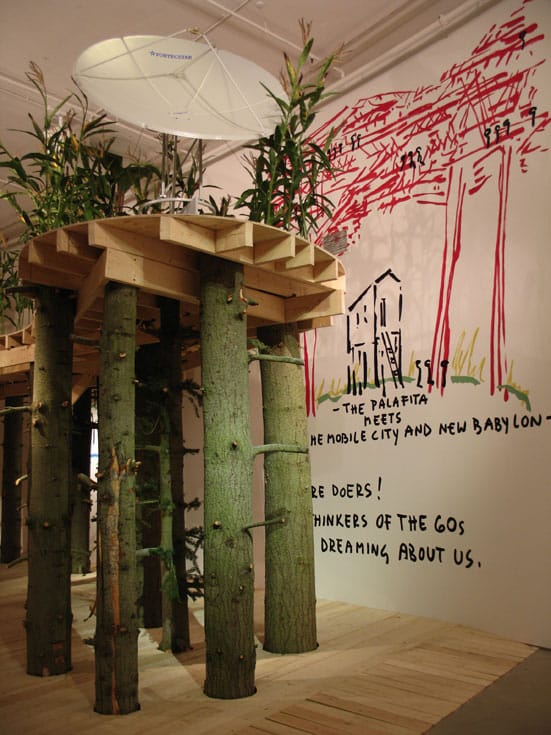24th May 2007 — 2nd September 2007
Entering
the Curve, a Galileo satellite hangs from the ceiling suspended
overhead; covering the wall from top to bottom, a series of simple
sketch-like wall drawings, a cross between an architectural case study
and an illustrated children's book, follow the story of the Croa River
community in Brazil. Like a fable or a parable the story begins in a
fairytale style: 'Far away from Sao Paulo, at the edge of the Amazonia:
a forest, a river, the Croa Community'. Half way through the narrative,
a video features a conversation between architect and artist Marjetica
Potrc and curator José Roca, taking us further deeper into the Croa
River community: a number of isolated territories that draw their
strength from their cultural identity and stand for self-organisation,
sustainable growth, and local knowledge. Reaffirming their territories,
they are actively participating in the creation of 21st century models
of coexistence, where the large metropolis is balanced by people who
consciously break away from it.
For the Croa River community education is the way to deliver confidence
and self-esteem to their own people. Thus, at the far end of the
installation, standing on a platform held by multiple rows of three
metres long tree trunks, we reach a 1:1 reconstruction of a colourful
pink and blue wooden rural school, equipped with solar panels and a
satellite disc to emphasise global connectivity as one of the
community's main concerns. Walking beneath the structure among the tree
trunks, the Spatial City envisaged in the late 1950s by architect Yona
Friedman quickly comes to mind. In Forest Rising, Potrc's latest
installation, the cities of the future, the utopias of the 1960s stand
next to the rural architecture developed by the isolated communities
that nest on the western corner of Brazil's Amazonian forest.
Forest Rising follows Potrc's previous investigations on contemporary
living conditions and alternative landscapes originated by communities
trapped in impoverished conditions. Her reconstructions of improvised
architectures that respond to primary living necessities, such as
shantytown houses, or assembled constructions from recycled materials,
propose specific solutions to improve the relations established between
the individual and society, as well as workable alternatives to
capitalist paradigms of urban development in situations of economic,
social or ecological change. Against current models of accumulation and
rapid growth, Potrc's focuses on those communities in which 'happiness
is to grow in small steps', as stated in one of the drawings of the
Croa River community series.
Based on her personal experience, Potrc travels from major metropolitan
centres to the peripheries, always looking for places that are
undergoing drastic social or economic changes; unregulated urban
developments; informal architectural structures or survival
technologies. Her work thus becomes a continuous process of learning
and sharing knowledge that she brings into the gallery, presenting
solutions that others have already adopted and developed in order to
re-establish and re-define the terms of their relationship with society
and the environment.
Forest Rising like many of other Potrc's reconstructions, is not a
model of living to be transmitted, copied or adapted somewhere else in
the world. It focuses on a community that suggests forms of living
together that go far beyond neo-liberalism's understanding of the
individual and market economies. In this community, 'being' always
means 'being with', and 'I' does not precede 'we'. When these models
enter the gallery and the art market, they loose their functionality,
but remain as existing realities in the places where they were first
originated. Therefore, Potrc's work does not propose yet another
utopia, as those to which she often refers, such as the architecture of
Constant or the world community imagined by Hélio Oiticica and Lygia
Clark. In contrast, Potrc's work is the reconstruction of current
realities: 'We are the doers', claims one of her drawings, 'the
thinkers of the 60s were dreaming about us'. In her constant search for
alternative modes of living and relations with the environment, her
work acts as a proof of the exhaustion reached by the conventional
models of distribution and arrangement of urban space in contemporary
western society, and at the same time it raises the awareness that
these other realities, so remote to us now, might one day become the
only feasible ones.
You can also currently see new work by Marjetica Potrc at her solo show
Florestania at Blow de la Barra, 35 Heddon Street, W1 until 30 June.
CJ
Barbican Art Gallery
Barbican Centre
Silk Street
London EC2Y 8D
http://www.barbican.org.uk/artgallery/
Open
Daily, 11am-8pm
Late night first Thurs, 11am-10pm

Marjetica Potrc
Forest Rising
Courtesy Barbican Art Gallery
(c) Lyndon Douglas